
Gulf of Mexico dead zone in July 2017. At 8,776 square miles, this year’s dead zone in the Gulf of Mexico is the largest ever measured. (Courtesy of N. Rabalais, LSU/LUMCON)
Less oxygen dissolved in the water is often referred to as a “dead zone” (in red above) because most marine life either dies, or, if they are mobile such as fish, leave the area. Habitats that would normally be teeming with life become, essentially, biological deserts. Captions and Image Source: NOAA.
Excerpts;
Each summer, a large part of the Gulf of Mexico “dies”. This year, the Gulf’s “dead zone” is the largest on record, stretching from the mouth of the Mississippi, along the coast of Louisiana to waters off Texas, hundreds of miles away. Around 8,776 square miles of ocean, an area the size of New Jersey or Wales, is almost lifeless…
Read Full Article; CBS News (08-11-2017)
Gulf of Mexico ‘dead zone’ is the largest ever measured; NOAA (08-02-2017)
Scientists have determined this year’s Gulf of Mexico “dead zone,” an area of low oxygen that can kill fish and marine life, is 8,776 square miles, an area about the size of New Jersey. It is the largest measured since dead zone mapping began there in 1985…
Industrial meat production is killing our seas; Guardian UK (08-04-2017)
Every spring, as the snows thaw, water rushes down the Mississippi and Missouri rivers, spreading life, then death into the Gulf of Mexico. The floodwaters are laden with fertilisers washed from fields and factory farms. As spring turns to summer, excessive nutrients first drive a huge bloom of living plankton, then cause death on a gargantuan scale as a dead zone blossoms across the seabed. Most years it grows swiftly to over 5,000 square miles of seabed, killing everything that cannot outrun it.
This year’s dead zone has engulfed 8,700 square miles, the biggest ever recorded…









